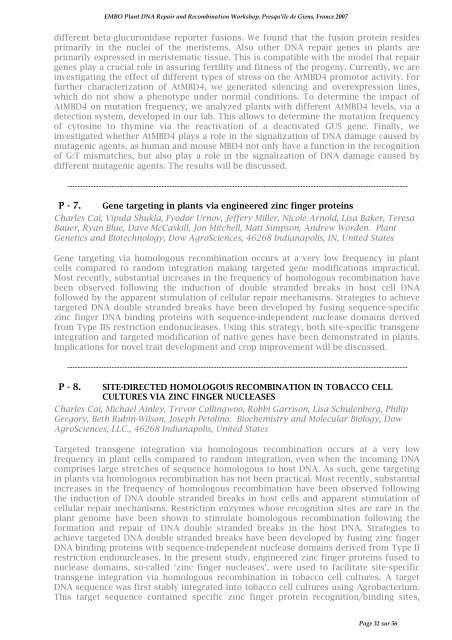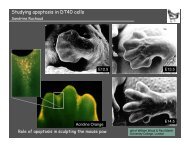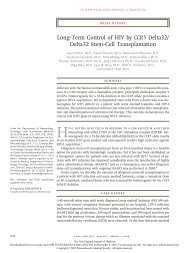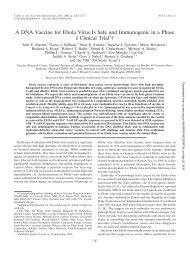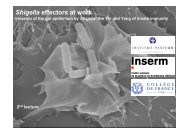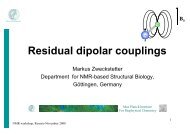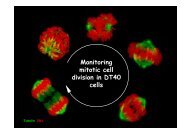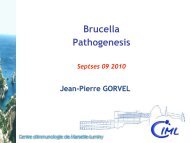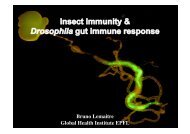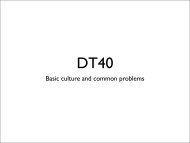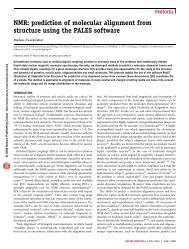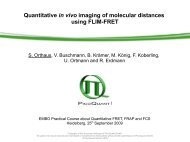pdf file - Events - EMBO
pdf file - Events - EMBO
pdf file - Events - EMBO
You also want an ePaper? Increase the reach of your titles
YUMPU automatically turns print PDFs into web optimized ePapers that Google loves.
<strong>EMBO</strong> Plant DNA Repair and Recombination Workshop, Presqu'île de Giens, France 2007<br />
different beta-glucuronidase reporter fusions. We found that the fusion protein resides<br />
primarily in the nuclei of the meristems. Also other DNA repair genes in plants are<br />
primarily expressed in meristematic tissue. This is compatible with the model that repair<br />
genes play a crucial role in assuring fertility and fitness of the progeny. Currently, we are<br />
investigating the effect of different types of stress on the AtMBD4 promotor activity. For<br />
further characterization of AtMBD4, we generated silencing and overexpression lines,<br />
which do not show a phenotype under normal conditions. To determine the impact of<br />
AtMBD4 on mutation frequency, we analyzed plants with different AtMBD4 levels, via a<br />
detection system, developed in our lab. This allows to determine the mutation frequency<br />
of cytosine to thymine via the reactivation of a deactivated GUS gene. Finally, we<br />
investigated whether AtMBD4 plays a role in the signalization of DNA damage caused by<br />
mutagenic agents, as human and mouse MBD4 not only have a function in the recognition<br />
of G:T mismatches, but also play a role in the signalization of DNA damage caused by<br />
different mutagenic agents. The results will be discussed.<br />
----------------------------------------------------------------------------------------------------------------------------------<br />
P - 7. Gene targeting in plants via engineered zinc finger proteins<br />
Charles Cai, Vipula Shukla, Fyodor Urnov, Jeffery Miller, Nicole Arnold, Lisa Baker, Teresa<br />
Bauer, Ryan Blue, Dave McCaskill, Jon Mitchell, Matt Simpson, Andrew Worden. Plant<br />
Genetics and Biotechnology, Dow AgroSciences, 46268 Indianapolis, IN, United States<br />
Gene targeting via homologous recombination occurs at a very low frequency in plant<br />
cells compared to random integration making targeted gene modifications impractical.<br />
Most recently, substantial increases in the frequency of homologous recombination have<br />
been observed following the induction of double stranded breaks in host cell DNA<br />
followed by the apparent stimulation of cellular repair mechanisms. Strategies to achieve<br />
targeted DNA double stranded breaks have been developed by fusing sequence-specific<br />
zinc finger DNA binding proteins with sequence-independent nuclease domains derived<br />
from Type IIS restriction endonucleases. Using this strategy, both site-specific transgene<br />
integration and targeted modification of native genes have been demonstrated in plants.<br />
Implications for novel trait development and crop improvement will be discussed.<br />
----------------------------------------------------------------------------------------------------------------------------------<br />
P - 8. SITE-DIRECTED HOMOLOGOUS RECOMBINATION IN TOBACCO CELL<br />
CULTURES VIA ZINC FINGER NUCLEASES<br />
Charles Cai, Michael Ainley, Trevor Collingwoo, Robbi Garrison, Lisa Schulenberg, Philip<br />
Gregory, Beth Rubin-Wilson, Joseph Petolino. Biochemistry and Molecular Biology, Dow<br />
AgroSciences, LLC., 46268 Indianapolis, United States<br />
Targeted transgene integration via homologous recombination occurs at a very low<br />
frequency in plant cells compared to random integration, even when the incoming DNA<br />
comprises large stretches of sequence homologous to host DNA. As such, gene targeting<br />
in plants via homologous recombination has not been practical. Most recently, substantial<br />
increases in the frequency of homologous recombination have been observed following<br />
the induction of DNA double stranded breaks in host cells and apparent stimulation of<br />
cellular repair mechanisms. Restriction enzymes whose recognition sites are rare in the<br />
plant genome have been shown to stimulate homologous recombination following the<br />
formation and repair of DNA double stranded breaks in the host DNA. Strategies to<br />
achieve targeted DNA double stranded breaks have been developed by fusing zinc finger<br />
DNA binding proteins with sequence-independent nuclease domains derived from Type II<br />
restriction endonucleases. In the present study, engineered zinc finger proteins fused to<br />
nuclease domains, so-called ‘zinc finger nucleases’, were used to facilitate site-specific<br />
transgene integration via homologous recombination in tobacco cell cultures. A target<br />
DNA sequence was first stably integrated into tobacco cell cultures using Agrobacterium.<br />
This target sequence contained specific zinc finger protein recognition/binding sites,<br />
Page 32 sur 56


